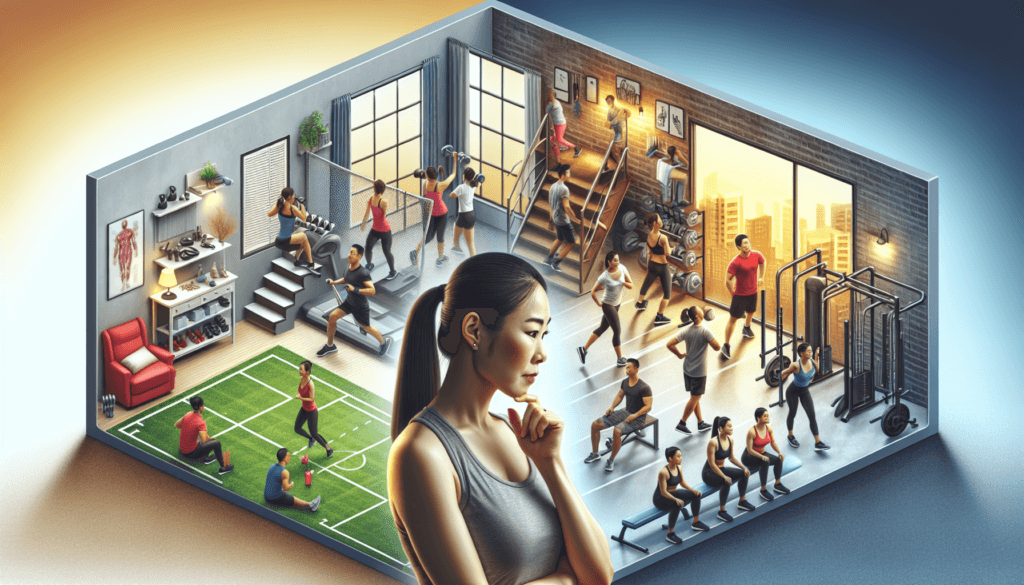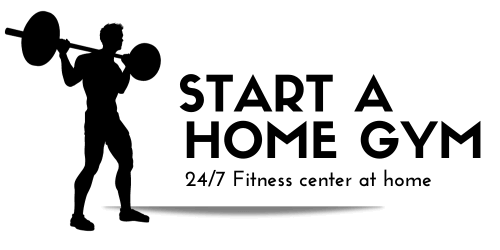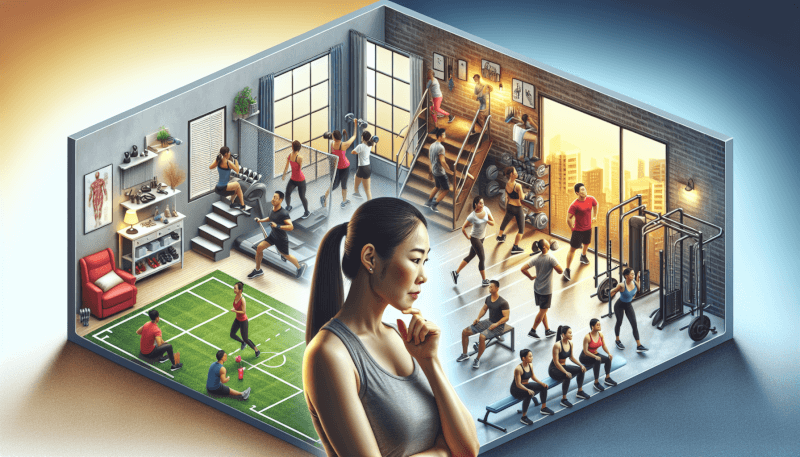Have you ever considered setting up a home gym? While it may seem like a dream come true for fitness enthusiasts, there are some drawbacks to keep in mind. In this article, we will explore why a home gym may not be the best option for everyone. From space constraints to limited equipment variety, we will delve into the disadvantages of having a home gym and help you make an informed decision about your fitness routine. So, before you invest in expensive equipment and rearrange your living space, let’s weigh the pros and cons together.

Lack of motivation
Having a home gym may seem like a convenient option, but it often lacks the necessary motivation to keep you going. When you are solely responsible for motivating yourself, it can be easy to make excuses and skip workouts. Without external accountability, it becomes more challenging to stay on track with your fitness goals.
No accountability
One of the main downsides of having a home gym is the lack of accountability. When you exercise at a public gym, you may feel a sense of responsibility to yourself and others to show up and stay committed. However, at home, it’s easy to give in to distractions and postpone your workouts. Without the pressure of others around you, it’s vital to find ways to hold yourself accountable to stay motivated.
Lack of social interaction
For many people, going to the gym is not just about getting a good workout; it’s also an opportunity to socialize. In a public gym, you have the chance to meet fellow fitness enthusiasts, share experiences, and even make new friends. In contrast, working out at home may lead to a lack of social interaction, which can contribute to feelings of isolation and a decrease in motivation.
Distractions at home
When your home doubles as your gym, it’s difficult to escape the distractions that come with it. The never-ending piles of laundry, the constant reminders of household chores, and the countless temptations surrounding you can all derail your workout routine. It takes a considerable amount of discipline to ignore these distractions and stay focused on your fitness goals, which can be a significant challenge for many individuals.
Financial considerations
Although a home gym may save you money in the long run, there are some financial considerations to take into account before creating one.
Initial investment
Setting up a home gym requires a significant initial investment. You need to purchase exercise equipment, such as weights, cardio machines, and possibly even specialized equipment for specific workouts. These costs can quickly add up, depending on the quality and variety of equipment you desire. It’s essential to determine your budget and make sure you can afford the necessary equipment for your fitness goals.
Maintenance costs
Maintaining your home gym equipment is another financial consideration to keep in mind. Over time, equipment may require repairs, replacement parts, or regular maintenance to ensure it remains safe and functional. These ongoing costs can further strain your budget, and neglecting maintenance can lead to potential safety hazards or decreased equipment lifespan.
Limited equipment options
Unlike a public gym, which provides access to various machines and equipment, a home gym often has limited options. While this can be suitable for some individuals, it may limit the range of workouts you can perform and the opportunity to target specific muscle groups. Depending on your fitness goals, this lack of equipment variety may not provide the necessary options to achieve the results you desire.

Space limitations
Another factor to consider when contemplating a home gym is the amount of space you have available.
Limited room for equipment
Space limitations can significantly impact the type and quantity of equipment you can have in your home gym. If you have a small apartment or limited space, it may be challenging to fit in larger exercise machines like treadmills or weight benches. As a result, you may need to compromise on the type of equipment you can have, potentially limiting your workout options.
Restrictions on exercise variety
With limited space, there may be restrictions on the types of exercises you can perform. For example, you may not have enough room to do full range-of-motion movements or plyometric exercises that require jumping or explosive movements. This limitation can hinder the variety and effectiveness of your workouts, potentially making it difficult to achieve your fitness goals.
Potential impact on home aesthetics
Integrating a home gym into your living space may impact the aesthetics of your home. Some individuals prioritize having a dedicated workout area, while others prefer to keep the gym equipment hidden away. Regardless of your preference, it’s important to consider how the presence of exercise equipment will affect the overall look and feel of your home. This consideration becomes crucial if you plan on entertaining guests or have a specific aesthetic vision for each room.
Lack of professional guidance
When you exercise at a public gym, you have access to personal trainers and fitness experts who can guide you through your workouts. However, in a home gym setup, this professional guidance is often lacking.
No personal trainer
A significant disadvantage of a home gym is the absence of a personal trainer. Personal trainers play a crucial role in designing effective workout programs, ensuring proper form, and pushing you to reach your fitness potential. Without their expertise, you may struggle to design balanced workout routines or achieve optimal results.
Lack of expert advice
Apart from personal trainers, public gyms typically offer access to fitness experts who can answer questions, provide advice, and motivate you during your workouts. Having a professional readily available to offer guidance can make a significant difference in your fitness journey. When exercising at home, you may miss out on this expert advice, leading to potential setbacks or lack of progress.
Increased risk of injury
Working out without professional guidance increases the risk of injury. Without someone to correct your form, provide modifications based on your fitness level, or ensure proper warm-up and cool-down routines, you may inadvertently put yourself at risk. Proper technique and injury prevention strategies play a crucial role in maintaining a safe and effective workout routine, which can be difficult to achieve without professional guidance.

Limited access to resources
Public gyms often provide an extensive range of resources, such as specialized equipment, different workout classes, and a variety of facilities. These resources may not be readily available when exercising at home.
Limited selection of equipment
One significant disadvantage of a home gym is the limited selection of equipment compared to a public gym. Public gyms invest in a wide range of machines and equipment to cater to various fitness preferences and goals. However, a home gym may lack the specialized equipment necessary for specific exercises or training techniques, limiting your ability to diversify your workouts fully.
Lack of variety in workouts
In addition to limited equipment options, exercising at home can lead to a lack of workout variety. Public gyms often offer a wide range of classes and activities, including yoga, Pilates, spin classes, and group fitness. These options provide diversity and help prevent monotony in your workout routine. When working out at home, you may miss out on the opportunity to try new activities and challenge yourself in different ways.
Absence of special facilities
Public gyms often have special facilities, such as swimming pools, sauna rooms, or basketball courts, that provide additional fitness opportunities. These facilities may not be accessible in a home gym setup, limiting your ability to engage in certain types of exercises or activities. Depending on your fitness preferences, this absence of special facilities may be a significant downside.
Lack of external motivation
Exercising in a home gym may lead to a lack of external motivation, which is essential for many individuals to keep up with their fitness routine.
Competition and camaraderie
A public gym environment thrives on competition and camaraderie. Whether it’s through organized fitness challenges, group classes, or workout partners, the presence of others can push you to work harder and achieve more. In contrast, a home gym setting may lack this competitive spirit and the sense of community that comes with it.
Opportunity for socializing
Public gyms provide opportunities for socializing before, during, and after workouts. Conversations with like-minded individuals can provide a sense of belonging and motivation. In a home gym, the absence of these social interactions can lead to a lack of external motivation and reduce the overall enjoyment of your fitness routine.
Motivation from trainers or classmates
Fitness trainers and classmates in group workout settings often offer encouragement and motivation during challenging workouts. Their presence helps to push you beyond your comfort zone, increasing your motivation and accountability. In a home gym, you may miss out on this external motivation and support, making it harder to stay consistent and motivated.

Potential loss of motivation
Monotony and lack of challenge can contribute to a loss of motivation when exercising in a home gym.
Monotonous environment
A home gym environment can become monotonous over time. Seeing the same walls and surroundings every day may lead to a lack of inspiration and excitement about your workout routine. The absence of a change in scenery and interaction with others can make your fitness journey feel stagnant and less enjoyable.
Lack of challenge
Public gyms often offer a variety of workout options and equipment that cater to different fitness levels. This diversity allows you to continually challenge yourself, set new goals, and stay motivated. In a home gym setup, it may be more challenging to create varied and challenging workouts, leading to a plateau in progress and a potential loss of motivation.
Difficulty in staying consistent
Without the external factors that motivate you to show up at a public gym, staying consistent with your workouts can become increasingly difficult. The comfort and convenience of exercising at home may lead to a mindset that it’s easy to skip a workout or put it off for later. Maintaining consistency is vital for achieving fitness goals, and the lack of external motivation in a home gym setting can make it harder to stay on track.
Overwhelming responsibility
Creating and maintaining a home gym comes with a set of responsibilities that can be overwhelming for some individuals.
Setting up and maintaining the gym
Designing a functional home gym requires careful planning and effort. You need to consider factors such as suitable flooring, ensuring proper ventilation, organizing the equipment, and optimizing the layout for efficiency. Additionally, maintaining cleanliness and safety, such as wiping down equipment and regularly checking for any wear and tear, becomes your responsibility.
Cleaning and organizing equipment
Unlike a public gym where staff members are responsible for cleaning and organizing equipment, a home gym relies solely on your efforts. Regular cleaning and maintenance of the equipment are necessary to ensure its longevity and to create a hygienic workout environment. For individuals with limited time or a dislike for household chores, these additional responsibilities may become burdensome.
Time-consuming logistics
Creating and managing a home gym can be time-consuming. From researching and purchasing the right equipment to setting it up and creating a workout schedule, there are several logistical aspects to consider. If you have a busy lifestyle or other commitments, dedicating time to these logistics can become overwhelming and potentially deter you from pursuing a home gym setup.
Impact on family or household members
A home gym setup can have an impact on your family or household members, which may need to be taken into account.
Shared space concerns
Using a room or portion of your living space for a home gym may encroach on shared spaces. This lack of privacy and personal space can lead to potential conflicts or discomfort among family or household members. It’s crucial to consider how the presence of a gym may affect the dynamics within your home and ensure everyone’s needs and expectations are taken into account.
Noise and disturbance
Home workouts can generate noise and disturbance, especially if you use heavyweights or engage in high-intensity exercises. These factors may cause disturbances to other family members or neighbors, leading to potential conflicts or interruptions during your workouts. Striking a balance between pursuing your fitness goals and being considerate of others is essential in a home gym setup.
Conflicting schedules
A home gym setup requires coordination and consideration of everyone’s schedules within the household. If you share the equipment or workout space with other family members, conflicts may arise when there are competing demands for its use. Aligning schedules and establishing clear boundaries and rules around gym usage can help minimize disruptions and ensure a harmonious coexistence within the household.
Limited access to professional equipment
While a home gym can provide convenience, it often has limitations when it comes to accessing professional-grade equipment and specialized machines.
Advanced training equipment
Public gyms often invest in advanced training equipment that is not readily available for home use. These specialized machines and tools, such as cardio machines with built-in heart rate monitors or strength training equipment with advanced resistance systems, can enhance your workouts and improve the effectiveness of your training. Investing in such professional-grade equipment for a home gym setup may be costly or impractical for many individuals.
Specialized machines
Certain workout techniques or training styles may require specialized machines or equipment that may not be feasible to incorporate into a home gym. For example, functional trainers or cable machines are common in public gyms, enabling a wide range of exercises that target specific muscle groups. Restricting your workout options due to a lack of specialized machines may limit the effectiveness and versatility of your exercise routine.
Higher quality facilities
Public gyms often offer high-quality facilities, such as Olympic-sized pools, indoor tracks, or saunas. These amenities provide additional opportunities for cross-training, injury recovery, or relaxation. Obtaining similar facilities within a home gym setup can be challenging, both financially and space-wise. Depending on your fitness priorities, the absence of such facilities may be a considerable disadvantage of a home gym.
In conclusion, while a home gym may offer convenience and flexibility, it may not be suitable for everyone. The lack of motivation, limited access to resources, and absence of professional guidance can hinder your fitness journey. Financial considerations, space limitations, and the impact on family or household members also need to be carefully weighed. Ultimately, it’s essential to evaluate your fitness goals, lifestyle, and preferences before deciding whether a home gym is the right fit for you.


